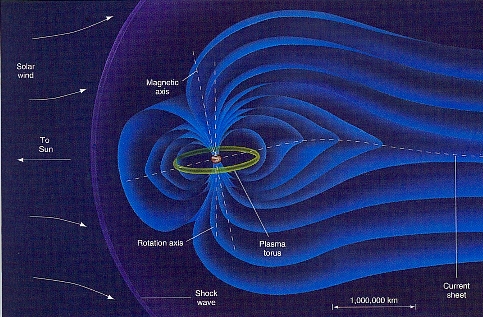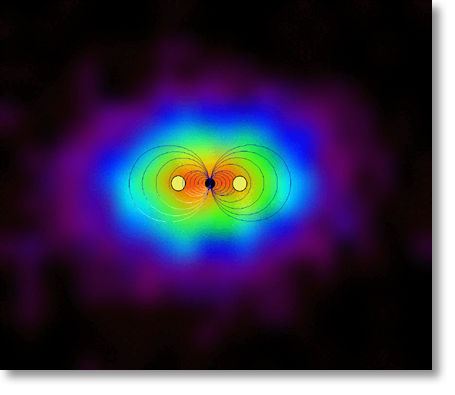Jupiter's Magnetosphere

A magnetosphere is the region of space surrounding a planet which is dominated by the planet's magnetic field. Jupiter's magnetosphere is enormous. In fact, it is the largest structure in the solar system. It is molded into a teardrop shape by a stream of energetic particles blowing away from the Sun called the solar wind. The side of the magnetosphere facing the Sun extends about 3 million kilometers from the planet, and its tail reaches out another 650 million kilometers, to the orbit of Saturn and beyond. If it were visible from Earth, it would appear several times larger in the sky than the full moon.
Jupiter's magnetic field is generated deep within the planet. Although its outer atmosphere is composed primarily of hydrogen gas, deep within the interior the pressure is so great that the hydrogen becomes a liquid. Because of the tremendous pressure, the electrons of the hydrogen atoms freely move from atom to atom, making it a very good conductor of electricity. Because of this property, it is referred to as liquid metallic hydrogen. Jupiter spins on its axis every 9.9 hours, generating convection currents in the liquid metallic hydrogen. This produces Jupiter's powerful magnetic field.
The Io plasma torus is located within Jupiter's magnetosphere and has considerable impact on it. The torus is a ring of charged particles associated with the volcanic activity on the moon. Radiation levels within the plasma torus are extreme and pose a serious threat to spacecraft.

This image taken on Jan. 4 and 5, 2001 by the Ion and Neutral Camera on NASA's Cassini spacecraft, makes the huge magnetosphere surrounding Jupiter visible in a way never seen before. Jupiter's magnetic field has been sketched over the image. The disk of Jupiter is shown by the black circle, and the approximate position of the Io plasma torus is represented by the yellow circles.
Illustration Credit: Chaisson, E./McMillian. S., ASTRONOMY TODAY, 3/e, © 1999. Electronically reproduced by permission of Prentice-Hall, Upper Saddle River, New Jersey. Photo Credit: NASA/JPL Photoglossary
Photoglossary
